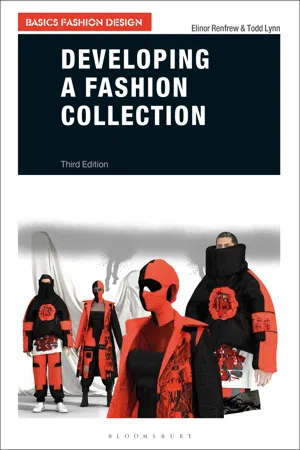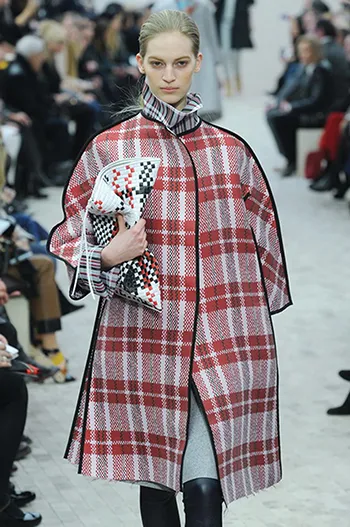![]()
1
What is a collection?
Designed and produced for sale – either through retailers or direct to customers – a collection is a range of garments, accessories or products brought together to tell a story. This range of pieces may be inspired by a trend, theme or design direction, reflecting cultural and social influences, and is usually produced for a season or particular occasion. A collection is a grouping of outfits or looks presented in a variety of ways, from catwalk shows at one of the international fashion weeks to online web pages. Collections, which may include runway, pre and capsule collections are aimed at different levels of the market and represent a designer’s vision and signature. This chapter introduces the concept of the collection and the processes involved in its development.
Figure 1.1 Céline by Phoebe Philo, A/W 2013.
To offer women something that feels more about investing in something and less about being disposable is a complete corrective to the world we live in.
Phoebe Philo
Figure 1.2 Burberry by Riccardo Tisci, A/W 2020.
Being a creative mind, you have to examine who you are every day.
Riccardo Tisci
How to start a collection
Any successful or financially viable collection requires an enormous amount of research, investigation and planning. Successful designers, manufacturers and retailers have a clear understanding of their customers’ needs, as well as an understanding of their position in a highly competitive market. In addition to the creation and realization of any collection, designers need to consider a range of issues if the final garments are to hang in customers’ closets.
If we look back at designers who have influenced fashion with their collections, all have one thing in common: an obsessive belief in their vision for a collection that represents their aesthetic and tells a story.
Collections also need to make a strong statement to inspire the press and the customers. This statement can range from a romantic historical narrative to a modern minimalistic collection based simply on clever use of cut or colour.
Pre-collections are an essential addition to the main seasonal collections, in order to generate more sales; designers are also introducing smaller, more specific collections, such as holiday and brand collaborations, derived from the main collection. For example, a designer for a Parisian house can be expected to design up to ten collections a year. At Chanel there will be two haute couture, two ready-to-wear, two pre-collections, a cruise and special Métiers d’Art shows (a limited edition demi-couture collection). All these shows will have anything from 70 to 120 looks per collection, but as sustainability is an overwhelmingly strong marketing force nowadays, the numbers of collections and products marketed per year are being reconsidered by many.
Brands now increasingly rely on ‘drops’ that are often based outside runway collections. ‘Drops’ are industry jargon for a selection of goods delivered at one time; according to Google, ‘Product drops are when a company releases a limited-edition product line for a short period of time. It’s an effective tactic for tapping into the competitive nature of consumers who are looking for unique products, as momentum builds around the exclusivity of a collection.’ (See page. 36)
Market research
Designing a collection involves research within two distinct areas: inspiration and markets. To gain an understanding of current fashion stock and ranges across market levels, many, if not all, designers will conduct a comp shop. This term refers to comparing stock in competitor retail outlets, regardless of market level. Quality of fabric, construction and detailing are carefully studied, alongside prices and origin of manufacturing. This provides a great deal of information that is useful when planning and selling a fashion collection. If it is not the first collection, market research involves looking back at what has sold well, comparing with competitors, and analysing why the customer will buy a certain product or pieces from a particular designer or brand.
Designers in larger companies will liaise with merchandisers to ensure that their creative vision is represented within the cost. Ultimately, it will be the fashion buyers who make the decision to order fashion collections, and their decisions are based on a combination of historical knowledge of their particular customers; sales figures, which track how many items of each piece within a collection were bought the previous season; delivery and availability of stock; quality of merchandise; exclusivity; and price.
Many small fashion businesses lack the infrastructure to access accurate market and marketing information. However, intuition and awareness of fashion directions will help a start-up label become commercially successful. Retail/store buyers are usually cautious when adopting new designers and therefore use a system of sale or return, or guaranteed sell-through models, which offers new talent the opportunity to showcase their collections alongside more established brands; they can then be picked up as the next new name if their collections sell. As a designer you must consider that if your collection doesn’t sell, pieces will be returned to you unsold and at your expense. These selling models are not always ideal for fledgling labels, as you may not receive a return on your investment.
Another way of launching a new fashion business is by concentrating on one particular piece or category. Many successful designers have started this way, later expanding into a range of items based on their hero product. Calvin Klein’s first collection was a range of women’s coats, for example; Ralph Lauren began his vast empire with a small collection of ties; and Laura Ashley started her global business with a humble printed tea towel. It’s worth noting that three power players in the world of fashion all started as luggage companies: Prada in 1913, Gucci in 1921, and Louis Vuitton in 1854 – the last of which only began developing and producing ready-to-wear in 1997 with Marc Jacobs as its first creative director.
Figure 1.3 Menswear on the sales floor at the opening of the Polo Ralph Lauren shop at Bloomingdale’s flagship 59th Street store in New York City.
The clothes that I design and everything I’ve done is about life and how people live and how they want to live and how they dream they’ll live. That’s what I do.
Ralph Lauren
Figure 1.4 Kate Moss models for John Galliano, S/S 1995.
Identifying the customer
By careful investigation and competitor analysis, designers can begin to identify a specific market area and customer for their fashion vision. At times, designers will create an imaginary situation where characters are involved in a plot, journey or scenario. The characters may be well-known historical figures or completely fictitious, but this collage of people and events can provide a rich starting point for imagining, visualizing and defining colours, fabrics and shapes without constraints. Although this makes for a romantic or stylized approach to customer profiling, most large companies are able to define every aspect of their customers through sales and specialist marketing information.
This information takes into account social and economic influences, and how customers’ lives are defined by a range of factors. Successful fashion producers are able to define their customers in relation to the business from the past and present to the future. It is possible to start with a fashion view, or purist approach to fashion, where an aspect of the process – perhaps creative cutting – informs the final pieces. The customer, occasion and cost remain considerations if the final garments are to work in any commercial context. However, not all pieces within a collection are designed on a commercial basis. Catwalk showpieces work as a promotional tool to attract the press, which helps to reinforce the designer’s popularity and currency.
Style is wearing an evening dress to McDonald’s, wearing heels to play football. It is personality, confidence and seduction.
John Galliano
Figure 1.5 Timothée Chalamet at the 2019 Venice Film Festival wearing Haider Ackermann, S/S 2020.
Figure 1.6 Alexander McQueen, S/S 2010.
You’ve got to know the rules to break them. That’s what I’m here for, to demolish the rules but to keep the tradition.
Alexander Mcqueen
Creativity versus wearability
Creativity is a subjective issue, as all fashion expresses a creative vision and process. Wearability is also subjective and rests with the consumer, who can make personal judgments about self-image, acceptability and suitability depending on occasion or lifestyle. Today’s consumer is inundated with fashion choices, and the media’s infatuation with fashion, celebrity and influence provides enormous coverage of how f...






